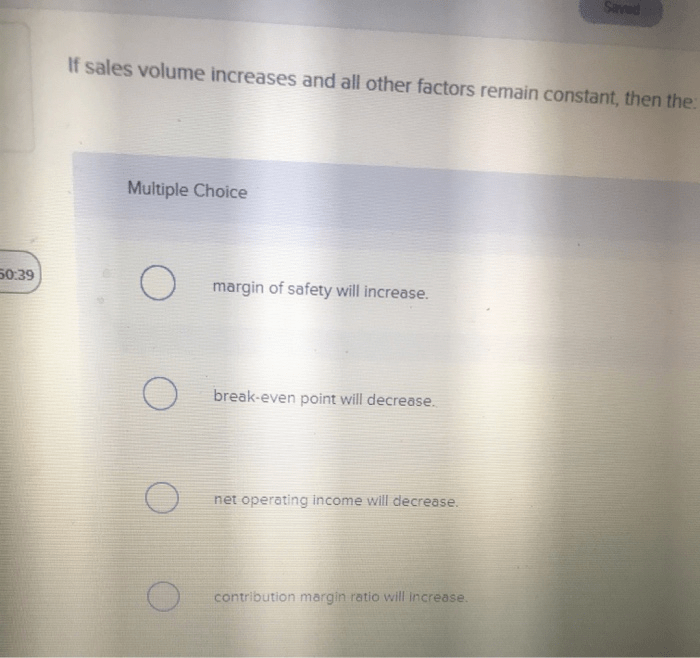If sales volume increases and all other factors remain constant, businesses experience a range of financial implications that impact profitability, cash flow, and overall performance. This comprehensive analysis delves into the intricate relationship between sales volume and key financial metrics, providing insights into the potential benefits and challenges associated with sales growth.
Understanding the impact of sales volume on various aspects of a business is crucial for effective decision-making, resource allocation, and strategic planning. By examining the interplay between sales volume and revenue, cost of goods sold, operating expenses, and other factors, businesses can optimize their operations to maximize profitability and achieve sustainable growth.
Sales Volume and Revenue

Increased sales volume typically leads to higher revenue. Revenue is the total amount of money earned from the sale of goods or services. When sales volume increases, the number of units sold increases, resulting in a higher total revenue.
For example, if a company sells 1,000 units of a product at $10 per unit, its revenue is $10,000. If the company increases its sales volume to 1,500 units, its revenue increases to $15,000.
However, there may be potential factors that could limit revenue growth despite increased sales volume. These factors include:
- Discounts and promotions: Offering discounts or promotions can reduce the average selling price per unit, resulting in lower revenue despite increased sales volume.
- Increased competition: Increased sales volume may attract competitors, leading to price wars and reduced profit margins.
- Production constraints: If a company cannot meet the increased demand, it may face production constraints, limiting its ability to generate additional revenue.
Cost of Goods Sold
Increased sales volume can affect the cost of goods sold (COGS). COGS is the cost incurred in producing or acquiring the goods or services sold. When sales volume increases, the company may need to purchase more raw materials, labor, or other inputs to meet the increased demand.
The concept of economies of scale suggests that as production volume increases, the average cost per unit of production decreases. This is because fixed costs, such as rent and equipment, are spread over a larger number of units.
However, there may be challenges in maintaining cost efficiency with increased sales volume. These challenges include:
- Supply chain disruptions: Increased sales volume can put pressure on the supply chain, leading to disruptions and increased costs.
- Inefficient production processes: If the company’s production processes are not optimized, increased sales volume can lead to higher production costs.
- Labor shortages: Increased sales volume may require additional labor, which can be difficult to find and may lead to higher labor costs.
Gross Profit Margin: If Sales Volume Increases And All Other Factors

Gross profit margin is a measure of profitability that is calculated as (Revenue – COGS) / Revenue. Increased sales volume can impact gross profit margin in the following ways:
- Increased revenue: As sales volume increases, revenue increases, which can positively impact gross profit margin.
- Increased COGS: Increased sales volume may lead to higher COGS, which can negatively impact gross profit margin.
Strategies to optimize gross profit margin in the context of increasing sales volume include:
- Negotiating better terms with suppliers: By negotiating better terms with suppliers, the company can reduce COGS and improve gross profit margin.
- Improving production efficiency: By improving production efficiency, the company can reduce COGS and improve gross profit margin.
- Introducing premium products: By introducing premium products with higher profit margins, the company can improve overall gross profit margin.
Operating Expenses

Operating expenses are the costs incurred in running the business, excluding COGS. Increased sales volume can affect operating expenses in the following ways:
- Fixed operating expenses: Fixed operating expenses, such as rent and salaries, remain relatively constant regardless of sales volume.
- Variable operating expenses: Variable operating expenses, such as sales commissions and shipping costs, increase as sales volume increases.
Strategies for controlling operating expenses while accommodating sales growth include:
- Outsourcing non-core functions: By outsourcing non-core functions, the company can reduce fixed operating expenses.
- Negotiating better terms with vendors: By negotiating better terms with vendors, the company can reduce variable operating expenses.
- Automating processes: By automating processes, the company can reduce labor costs and improve efficiency.
Net Income

Net income is the profit left over after subtracting all expenses from revenue. Increased sales volume can impact net income in the following ways:
- Increased revenue: As sales volume increases, revenue increases, which can positively impact net income.
- Increased COGS: Increased sales volume may lead to higher COGS, which can negatively impact net income.
- Increased operating expenses: Increased sales volume may lead to higher operating expenses, which can negatively impact net income.
Potential challenges in maintaining profitability with increased sales volume include:
- Competition: Increased sales volume may attract competitors, leading to price wars and reduced profit margins.
- Rising costs: Increased sales volume may lead to higher costs, such as raw materials and labor, which can reduce profitability.
- Inefficient operations: If the company’s operations are not efficient, increased sales volume can lead to lower profitability.
Questions and Answers
How does increased sales volume impact revenue?
Increased sales volume generally leads to higher revenue, as more products or services are sold. However, factors such as discounts, returns, and product mix can influence the actual revenue generated.
What is the relationship between sales volume and cost of goods sold?
Increased sales volume can lead to economies of scale, reducing the cost of goods sold per unit. However, factors such as supply chain disruptions and rising raw material costs can affect this relationship.
How does sales volume affect gross profit margin?
Gross profit margin is calculated as (Revenue – Cost of Goods Sold) / Revenue. Increased sales volume can positively impact gross profit margin if the cost of goods sold does not increase proportionally.
What are the potential challenges associated with increased sales volume?
Increased sales volume can strain resources, such as inventory, production capacity, and customer service. Managing these challenges effectively is crucial to maintain profitability and customer satisfaction.